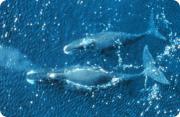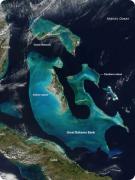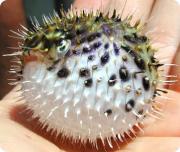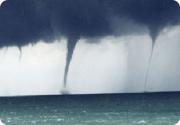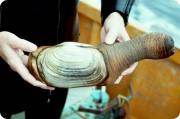Radio Program
Our regular Science and the SeaTM radio program presents marine science topics in an engaging two-minute story format. Our script writers gather ideas for the radio program from the University of Texas Marine Science Institute's researchers and from our very popular college class, Introduction to Oceanography, which we teach to hundreds of non-science majors at The University of Texas at Austin every year. Our radio programs are distributed at to commercial and public radio stations across the country.
Even to the untrained eye, it’s obvious that the waters of the world’s oceans aren’t the same. The crystalline waters of the Caribbean don’t look at all like the muddy waters off the mouth of the Amazon River.
The difference isn’t limited to the surface, though. In fact, different water masses are stacked atop each other like the layers of a cake.
For a shark, retirement paradise isn’t Florida. Instead, it just may be one of two small island-nations that recently banned shark fishing from their territorial waters.
Being right isn’t necessarily a good thing.
Consider a species of whale that once roamed the North Atlantic by the thousands. It’s slow, it swims close to shore, and it has a lot of blubber. These qualities made it the “right” whale for hunters, so it was called the right whale. But so many were caught that the species almost became extinct -- and could still.
Ice is no problem for a whale that lives its entire life in Arctic waters. It simply rams its way through -- cracking ice that can be up to two feet thick. Its “ram” is a thick skullbone that looks like an archer’s bow -- earning the whale its name: the bowhead.
It may be one of the longest-lived mammals on the planet. Scientists have dug out harpoon points that were more than a century old. And it’s possible that one bowhead was more than 200 years old when he died a couple of decades ago.
To build an island these days, all you need is a few years, a few million tons of sand and rock, and a few billion dollars. In fact, developers from Hong Kong to Dubai have built islands with just that formula.
{mosimage}
To build an island the old-fashioned way, though, you need a lot more time -- but a lot less money.
Fish have many ways to protect themselves from predators. Some use their color and texture to blend into the background. Some dig into the mud at the ocean floor. And some are so fast they simply jet away.
And one species uses a bit of bluster: It puffs up like a balloon to make itself look more impressive. If that doesn’t work, it’s covered in sharp spines that give attackers a nasty surprise.
Residents of the Florida Keys are on the alert for marine storms at this time of year -- and not just hurricanes. Much smaller storms twist around the island chain, too -- up to several hundred a year. They look like skinny tornadoes -- rope-like funnels that twist across the water for a few minutes.
Water spouts are most common around the Keys, but they’re found in other coastal regions around the country and around the world.
Smugglers sneak tons of it out of the country every year. Other ne’er-do-wells under-report the amount of it they’ve sold on their incomes taxes, and even trade drugs for it. Is it diamonds? Gold? Lady Gaga CDs?
How about the world’s largest burrowing clam -- a monster with a three-foot neck that can live for more than a century. It’s a delicacy on both sides of the Pacific Ocean -- fetching up to $60 a pop in parts of Asia.
“Snowbirds” are popular visitors along the Texas coast -- people who flee the cold northern winters for the warm beaches. And over the last third of a century, those beaches have been getting a little warmer. At Corpus Christi, for example, the winter temperature has climbed by about five degrees Fahrenheit.
{mosimage}
It sounds like something from an episode of the original “Iron Chef.” Take two halves of a coconut shell, place an octopus inside, then simmer in saltwater.
Except for the “simmer” part, it’s a recipe that a species of octopus created on its own. It’s the first clear example of an octopus using tools to improve its life.
Marine biologists already knew that octopuses are smart. They use pebbles to wall up the entrances to their dens, and in captivity, they can pry open the tops of their tanks and dip their arms into other tanks.

